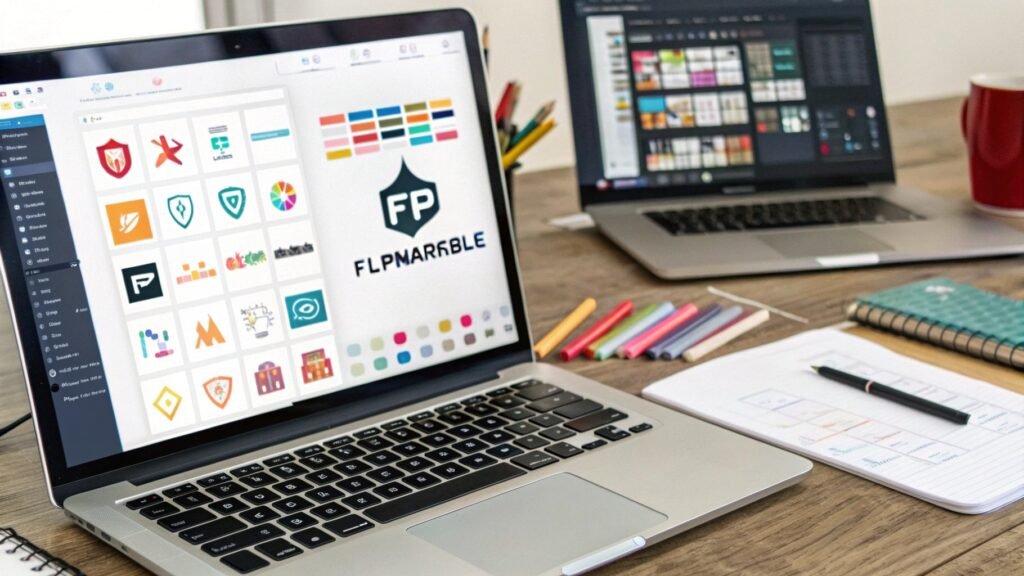Understanding Logos Flpmarkable
Logos flpmarkable represent a pivotal element in the branding landscape, serving as visual anchors that encapsulate a company’s identity. A logo is often the first interaction a consumer has with a brand, making its design crucial. The uniqueness of logos flpmarkable comes from their ability to convey a brand’s ethos, values, and mission through carefully crafted design elements. This is where creativity intertwines with strategic thinking, resulting in a logo that not only captures attention but also instills trust and communicates professionalism.
In the realm of branding, the significance of a well-designed logo cannot be overstated. It acts as a shorthand to represent the broader qualities and benefits of a company. Memorable logos flpmarkable are characterized by simplicity, relevance, and versatility. Brands that invest in standout logos benefit from heightened consumer recognition, often leading to increased loyalty and competitive advantage. The integration of unique design elements—such as color schemes, typography, and shapes—helps create a visual identity that resonates with target audiences.
Furthermore, the psychological impact of logos flpmarkable on consumer perception is noteworthy. Studies indicate that well-designed logos evoke emotional responses and can influence purchasing decisions. A logo that aligns with consumers’ values and aesthetics can foster positive associations and enhance brand recall. Ultimately, the goal of creating logos flpmarkable is to establish a lasting impression that distinguishes a brand in a crowded marketplace. As businesses navigate the complexities of consumer behavior, the importance of a thoughtfully designed logo becomes increasingly clear, emphasizing the need for creativity and strategic branding in today’s competitive environment.
Key Elements of Logos Flpmarkable
The effectiveness of logos flpmarkable is deeply rooted in a few key design principles that contribute to their memorability and impact. Among these principles, color psychology plays a pivotal role. The choice of color can evoke specific emotions and responses in viewers, serving to reinforce a brand’s identity. For instance, blue often communicates trust and dependability, making it a popular choice for financial institutions, while red can evoke excitement and urgency, frequently used by fast-food chains to stimulate appetite.
Another critical component in successful logos flpmarkable is typography. The font selection not only influences the aesthetic appeal but also conveys the brand’s personality. A tech company may opt for sleek, modern fonts to symbolize innovation, while a boutique might use elegant, script fonts to convey sophistication. The readability of the typeface is essential, ensuring that it remains clear and recognizable across various platforms and sizes. For example, the FedEx logo cleverly incorporates an arrow in its typography, symbolizing speed and precision, while still maintaining readability.
Simplicity is another foundational element that ensures logos flpmarkable resonate with audiences. A complex logo may struggle to communicate its message, while a simple design can be easily recognized and remembered. The Nike swoosh and Apple’s apple are prime examples of logos that embody simplicity, effectively encapsulating their brands in a minimalistic form. These logos not only reflect their respective brands but also allow for versatility across various mediums, from business cards to billboards.
Incorporating these key elements—color psychology, typography, and simplicity—helps create logos flpmarkable that not only represent the brand’s identity but also foster an emotional connection with their audience, ensuring lasting impressions and brand loyalty.

Creating Your Own Logos Flpmarkable
Creating a logos flpmarkable begins with a clear understanding of the brand it represents. Start by brainstorming ideas that encapsulate the values, mission, and vision of the brand. Creating a mind map can be helpful to visualize concepts and explore different avenues for design. Consider the target audience and how the logo can resonate with them. This understanding lays the foundation for subsequent design stages.
Once you have a list of potential ideas, proceed to sketch concepts. Sketching is a vital step in the design process, enabling you to experiment with various shapes, symbols, and layouts without committing to a digital format. Aim for simplicity and clarity; a flpmarkable logo should be easily recognizable and versatile. Don’t hesitate to create multiple iterations, as this will enhance your creative exploration.
After developing a range of sketches, it’s time to transition to digital tools. Software such as Adobe Illustrator or Canva offers powerful features for logo design. When digitalizing your sketches, ensure that you maintain the essence of your original ideas while refining the lines and colors. Focus on color selection, as color psychology plays a crucial role in branding; different hues evoke distinct emotions and responses.
Gathering feedback is essential to refine your logos flpmarkable. Share your designs with peers, stakeholders, or potential customers to gain insights on their perceptions. Constructive criticism can reveal important aspects that you may have overlooked. Encourage specific feedback about color choices, clarity, and overall impression. Once you have received proper feedback, take time to iterate on your designs, enhancing them based on the suggestions you found valuable.
By following these steps, you will be well on your way to creating a logos flpmarkable that effectively communicates your brand’s identity and message, ultimately contributing to its overall success.
Case Studies: Successful Logos Flpmarkable
Logos play a pivotal role in brand identity, acting as a visual cornerstone that encapsulates a company’s ethos and market position. Several brands have successfully leveraged what can be classified as logos flpmarkable, resulting in significant enhancements to their overall brand recognition and consumer engagement. By analyzing these case studies, one can discern the elements that contribute to a logo’s effectiveness and its reception among the target audience.
One prime example is the logo of a renowned athletic brand, which utilizes a simple yet powerful design. This logo incorporates an abstract symbol combined with a bold typeface, effectively communicating strength and agility. Its minimalistic style resonates with the brand’s core values, making it instantly recognizable across various platforms. Research indicates that this logo’s widespread acceptance has resulted in a 20% increase in sales, demonstrating the profound impact of effective logo design.
Another notable case involves a tech company that recently underwent a rebranding initiative. Their previous logo was deemed outdated and inconsistent with modern design trends. The new logos flpmarkable was crafted using vibrant colors and geometric shapes that embody innovation and forward-thinking. Following the launch, surveys revealed a 35% increase in brand favorability among its target demographic. This design not only drew attention but also cultivated a fresh narrative around the company’s forward-looking technology.
Lastly, a lifestyle brand successfully utilized a logos flpmarkable that intertwined its core ideals with cultural symbolism. By integrating elements that resonate with its audience’s values, the brand saw a substantial increase in customer loyalty and social media engagement. The logo became a cultural reference point, strengthening the brand’s market positioning. Such outcomes underscore the transformative power of exceptional logo design in crafting a brand’s identity, thus inspiring others to explore their own creative avenues.



